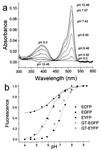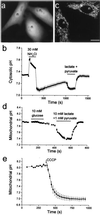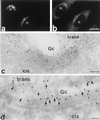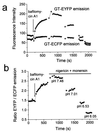Measurement of cytosolic, mitochondrial, and Golgi pH in single living cells with green fluorescent proteins
- PMID: 9618493
- PMCID: PMC22642
- DOI: 10.1073/pnas.95.12.6803
Measurement of cytosolic, mitochondrial, and Golgi pH in single living cells with green fluorescent proteins
Abstract
Many cellular events depend on a tightly compartmentalized distribution of H+ ions across membrane-bound organelles. However, measurements of organelle pH in living cells have been scarce. Several mutants of the Aequorea victoria green fluorescent protein (GFP) displayed a pH-dependent absorbance and fluorescent emission, with apparent pKa values ranging from 6.15 (mutations F64L/S65T/H231L) and 6.4 (K26R/F64L/S65T/Y66W/N146I/M153T/ V163A/N164H/H231L) to a remarkable 7.1 (S65G/S72A/T203Y/H231L). We have targeted these GFPs to the cytosol plus nucleus, the medial/trans-Golgi by fusion with galactosyltransferase, and the mitochondrial matrix by using the targeting signal from subunit IV of cytochrome c oxidase. Cells in culture transfected with these cDNAs displayed the expected subcellular localization by light and electron microscopy and reported local pH that was calibrated in situ with ionophores. We monitored cytosolic and nuclear pH of HeLa cells, and mitochondrial matrix pH in HeLa cells and in rat neonatal cardiomyocytes. The pH of the medial/trans-Golgi was measured at steady-state (calibrated to be 6.58 in HeLa cells) and after various manipulations. These demonstrated that the Golgi membrane in intact cells is relatively permeable to H+, and that Cl- serves as a counter-ion for H+ transport and likely helps to maintain electroneutrality. The amenability to engineer GFPs to specific subcellular locations or tissue targets using gene fusion and transfer techniques should allow us to examine pH at sites previously inaccessible.
Figures






References
Publication types
MeSH terms
Substances
Grants and funding
LinkOut - more resources
Full Text Sources
Other Literature Sources

